#nation trust corporate online platform
Explore tagged Tumblr posts
Text
#rpa in banking case study#rpa solutions#rpa success stories in banking#rpa case studies in banking#rpa banking customer onboarding#nation trust corporate online platform#nations trust bank online banking#rpa automation in banking
0 notes
Text
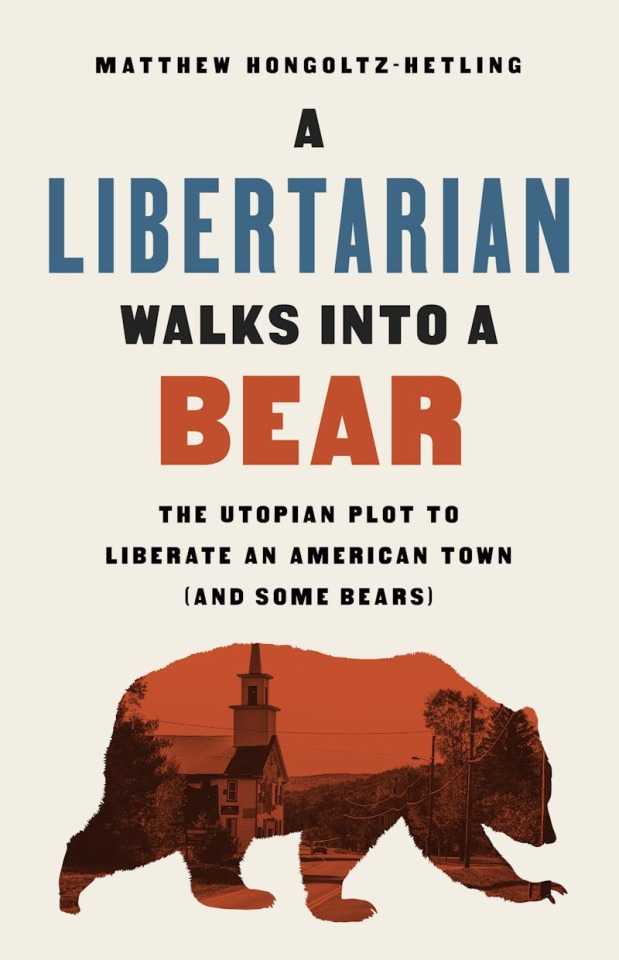
A Libertarian Walks Into a Bear: The Utopian Plot to Liberate an American Town (and Some Bears)
PublicAffairs, 288 pp., $28.00
But don’t worry—it almost never comes to this. As one park service PSA noted this summer, bears “usually just want to be left alone. Don’t we all?” In other words, if you encounter a black bear, try to look big, back slowly away, and trust in the creature’s inner libertarian. Unless, that is, the bear in question hails from certain wilds of western New Hampshire. Because, as Matthew Hongoltz-Hetling’s new book suggests, that unfortunate animal may have a far more aggressive disposition, and relate to libertarianism first and foremost as a flavor of human cuisine.
Hongoltz-Hetling is an accomplished journalist based in Vermont, a Pulitzer nominee and George Polk Award winner. A Libertarian Walks Into a Bear: The Utopian Plot to Liberate an American Town (and Some Bears) sees him traversing rural New England as he reconstructs a remarkable, and remarkably strange, episode in recent history. This is the so-called Free Town Project, a venture wherein a group of libertarian activists attempted to take over a tiny New Hampshire town, Grafton, and transform it into a haven for libertarian ideals—part social experiment, part beacon to the faithful, Galt’s Gulch meets the New Jerusalem. These people had found one another largely over the internet, posting manifestos and engaging in utopian daydreaming on online message boards. While their various platforms and bugbears were inevitably idiosyncratic, certain beliefs united them: that the radical freedom of markets and the marketplace of ideas was an unalloyed good; that “statism” in the form of government interference (above all, taxes) was irredeemably bad. Left alone, they believed, free individuals would thrive and self-regulate, thanks to the sheer force of “logic,” “reason,” and efficiency. For inspirations, they drew upon precedents from fiction (Ayn Rand loomed large) as well as from real life, most notably a series of micro-nation projects ventured in the Pacific and Caribbean during the 1970s and 1980s.
None of those micro-nations, it should be observed, panned out, and things in New Hampshire don’t bode well either—especially when the humans collide with a newly brazen population of bears, themselves just “working to create their own utopia,” property lines and market logic be damned. The resulting narrative is simultaneously hilarious, poignant, and deeply unsettling. Sigmund Freud once described the value of civilization, with all its “discontents,” as a compromise product, the best that can be expected from mitigating human vulnerability to “indifferent nature” on one hand and our vulnerability to one another on the other. Hongoltz-Hetling presents, in microcosm, a case study in how a politics that fetishizes the pursuit of “freedom,” both individual and economic, is in fact a recipe for impoverishment and supercharged vulnerability on both fronts at once. In a United States wracked by virus, mounting climate change, and ruthless corporate pillaging and governmental deregulation, the lessons from one tiny New Hampshire town are stark indeed.
“In a country known for fussy states with streaks of independence,” Hongoltz-Hetling observes, “New Hampshire is among the fussiest and the streakiest.” New Hampshire is, after all, the Live Free or Die state, imposing neither an income nor a sales tax, and boasting, among other things, the highest per capita rate of machine gun ownership. In the case of Grafton, the history of Living Free—so to speak—has deep roots. The town’s Colonial-era settlers started out by ignoring “centuries of traditional Abenaki law by purchasing land from founding father John Hancock and other speculators.” Next, they ran off Royalist law enforcement, come to collect lumber for the king, and soon discovered their most enduring pursuit: the avoidance of taxes. As early as 1777, Grafton’s citizens were asking their government to be spared taxes and, when they were not, just stopped paying them.
Nearly two and a half centuries later, Grafton has become something of a magnet for seekers and quirky types, from adherents of the Unification Church of the Reverend Sun Myung Moon to hippie burnouts and more. Particularly important for the story is one John Babiarz, a software designer with a Krusty the Klown laugh, who decamped from Big-Government-Friendly Connecticut in the 1990s to homestead in New Hampshire with his equally freedom-loving wife, Rosalie. Entering a sylvan world that was, Hongoltz-Hetling writes, “almost as if they had driven through a time warp and into New England’s revolutionary days, when freedom outweighed fealty and trees outnumbered taxes,” the two built a new life for themselves, with John eventually coming to head Grafton’s volunteer fire department (which he describes as a “mutual aid” venture) and running for governor on the libertarian ticket.
Although John’s bids for high office failed, his ambitions remained undimmed, and in 2004 he and Rosalie connected with a small group of libertarian activists. Might not Grafton, with its lack of zoning laws and low levels of civic participation, be the perfect place to create an intentional community based on Logic and Free Market Principles? After all, in a town with fewer than 800 registered voters, and plenty of property for sale, it would not take much for a committed group of transplants to establish a foothold, and then win dominance of municipal governance. And so the Free Town Project began. The libertarians expected to be greeted as liberators, but from the first town meeting, they faced the inconvenient reality that many of Grafton’s presumably freedom-loving citizens saw them as outsiders first, and compatriots second—if at all. Tensions flared further when a little Googling revealed what “freedom” entailed for some of the new colonists. One of the original masterminds of the plan, a certain Larry Pendarvis, had written of his intention to create a space honoring the freedom to “traffic organs, the right to hold duels, and the God-given, underappreciated right to organize so-called bum fights.” He had also bemoaned the persecution of the “victimless crime” that is “consensual cannibalism.” (“Logic is a strange thing,” observes Hongoltz-Hetling.)
While Pendarvis eventually had to take his mail-order Filipina bride business and dreams of municipal takeovers elsewhere (read: Texas), his comrades in the Free Town Project remained undeterred. Soon, they convinced themselves that, evidence and reactions to Pendarvis notwithstanding, the Project must actually enjoy the support of a silent majority of freedom-loving Graftonites. How could it not? This was Freedom, after all. And so the libertarians keep coming, even as Babiarz himself soon came to rue the fact that “the libertarians were operating under vampire rules—the invitation to enter, once offered, could not be rescinded.” The precise numbers are hard to pin down, but ultimately the town’s population of a little more than 1,100 swelled with 200 new residents, overwhelmingly men, with very strong opinions and plenty of guns.
Hongoltz-Hetling profiles many newcomers, all of them larger-than-life, yet quite real. The people who joined the Free Town Project in its first five years were, as he describes, “free radicals”—men with “either too much money or not enough,” with either capital to burn or nothing to lose. There’s John Connell of Massachusetts, who arrived on a mission from God, liquidated his savings, and bought the historic Grafton Center Meetinghouse, transforming it into the “Peaceful Assembly Church,” an endeavor that mixed garish folk art, strange rants from its new pastor (Connell himself), and a quixotic quest to secure tax exemption while refusing to acknowledge the legitimacy of the IRS to grant it. There’s Adam Franz, a self-described anti-capitalist who set up a tent city to serve as “a planned community of survivalists,” even though no one who joined it had any real bushcraft skills. There’s Richard Angell, an anti-circumcision activist known as “Dick Angel.” And so on. As Hongoltz-Hetling makes clear, libertarianism can indeed have a certain big-tent character, especially when the scene is a new landscape of freedom-lovers making “homes out of yurts and RVs, trailers and tents, geodesic domes and shipping containers.”
If the Libertarian vision of Freedom can take many shapes and sizes, one thing is bedrock: “Busybodies” and “statists” need to stay out of the way. And so the Free Towners spent years pursuing an aggressive program of governmental takeover and delegitimation, their appetite for litigation matched only by their enthusiasm for cutting public services. They slashed the town’s already tiny yearly budget of $1 million by 30 percent, obliged the town to fight legal test case after test case, and staged absurd, standoffish encounters with the sheriff to rack up YouTube hits. Grafton was a poor town to begin with, but with tax revenue dropping even as its population expanded, things got steadily worse. Potholes multiplied, domestic disputes proliferated, violent crime spiked, and town workers started going without heat. “Despite several promising efforts,” Hongoltz-Hetling dryly notes, “a robust Randian private sector failed to emerge to replace public services.” Instead, Grafton, “a haven for miserable people,” became a town gone “feral.” Enter the bears, stage right.
Black bears, it should be stressed, are generally a pretty chill bunch. The woods of North America are home to some three-quarters of a million of them; on average, there is at most one human fatality from a black bear attack per year, even as bears and humans increasingly come into contact in expanding suburbs and on hiking trails. But tracking headlines on human-bear encounters in New England in his capacity as a regional journalist in the 2000s, Hongoltz-Hetling noticed something distressing: The black bears in Grafton were not like other black bears. Singularly “bold,” they started hanging out in yards and on patios in broad daylight. Most bears avoid loud noises; these casually ignored the efforts of Graftonites to run them off. Chickens and sheep began to disappear at alarming rates. Household pets went missing, too. One Graftonite was playing with her kittens on her lawn when a bear bounded out of the woods, grabbed two of them, and scarfed them down. Soon enough, the bears were hanging out on porches and trying to enter homes.
Combining wry description with evocative bits of scientific fact, Hongoltz-Hetling’s portrayal of the bears moves from comical if foreboding to downright terrifying. These are animals that can scent food seven times farther than a trained bloodhound, that can flip 300-pound stones with ease, and that can, when necessary, run in bursts of speed rivaling a deer’s. When the bears finally start mauling humans—attacking two women in their homes—Hongoltz-Hetling’s relation of the scenes is nightmarish. “If you look at their eyes, you understand,” one survivor tells him, “that they are completely alien to us.”
What was the deal with Grafton’s bears? Hongoltz-Hetling investigates the question at length, probing numerous hypotheses for why the creatures have become so uncharacteristically aggressive, indifferent, intelligent, and unafraid. Is it the lack of zoning, the resulting incursion into bear habitats, and the reluctance of Graftonites to pay for, let alone mandate, bear-proof garbage bins? Might the bears be deranged somehow, perhaps even disinhibited and emboldened by toxoplasmosis infections, picked up from eating trash and pet waste from said unsecured bins? There can be no definitive answer to these questions, but one thing is clear: The libertarian social experiment underway in Grafton was uniquely incapable of dealing with the problem. “Free Towners were finding that the situations that had been so easy to problem-solve in the abstract medium of message boards were difficult to resolve in person.”
Grappling with what to do about the bears, the Graftonites also wrestled with the arguments of certain libertarians who questioned whether they should do anything at all—especially since several of the town residents had taken to feeding the bears, more or less just because they could. One woman, who prudently chose to remain anonymous save for the sobriquet “Doughnut Lady,” revealed to Hongoltz-Hetling that she had taken to welcoming bears on her property for regular feasts of grain topped with sugared doughnuts. If those same bears showed up on someone else’s lawn expecting similar treatment, that wasn’t her problem. The bears, for their part, were left to navigate the mixed messages sent by humans who alternately threw firecrackers and pastries at them. Such are the paradoxes of Freedom. Some people just “don’t get the responsibility side of being libertarians,” Rosalie Babiarz tells Hongoltz-Hetling, which is certainly one way of framing the problem.
Pressed by bears from without and internecine conflicts from within, the Free Town Project began to come apart. Caught up in “pitched battles over who was living free, but free in the right way,” the libertarians descended into accusing one another of statism, leaving individuals and groups to do the best (or worst) they could. Some kept feeding the bears, some built traps, others holed up in their homes, and still others went everywhere toting increasingly larger-caliber handguns. After one particularly vicious attack, a shadowy posse formed and shot more than a dozen bears in their dens. This effort, which was thoroughly illegal, merely put a dent in the population; soon enough, the bears were back in force.
Meanwhile, the dreams of numerous libertarians came to ends variously dramatic and quiet. A real estate development venture known as Grafton Gulch, in homage to the dissident enclave in Ayn Rand’s Atlas Shrugged, went belly-up. After losing a last-ditch effort to secure tax exemption, a financially ruined Connell found himself unable to keep the heat on at the Meetinghouse; in the midst of a brutal winter, he waxed apocalyptic and then died in a fire. Franz quit his survivalist commune, which soon walled itself off into a prisonlike compound, the better to enjoy freedom. And John Babiarz, the erstwhile inaugurator of the Project, became the target of relentless vilification by his former ideological cohorts, who did not appreciate his refusal to let them enjoy unsecured blazes on high-wildfire–risk afternoons. When another, higher-profile libertarian social engineering enterprise, the Free State Project, received national attention by promoting a mass influx to New Hampshire in general (as opposed to just Grafton), the Free Town Project’s fate was sealed. Grafton became “just another town in a state with many options,” options that did not have the same problem with bears.
Or at least—not yet. Statewide, a perverse synergy between conservationist and austerity impulses in New Hampshire governance has translated into an approach to “bear management” policy that could accurately be described as laissez-faire. When Graftonites sought help from New Hampshire Fish and Game officials, they received little more than reminders that killing bears without a license is illegal, and plenty of highly dubious victim-blaming to boot. Had not the woman savaged by a bear been cooking a pot roast at the time? No? Well, nevertheless. Even when the state has tried to rein in the population with culls, it has been too late. Between 1998 and 2013, the number of bears doubled in the wildlife management region that includes Grafton. “Something’s Bruin in New Hampshire—Learn to Live with Bears,” the state’s literature advises.
The bear problem, in other words, is much bigger than individual libertarian cranks refusing to secure their garbage. It is a problem born of years of neglect and mismanagement by legislators, and, arguably, indifference from New Hampshire taxpayers in general, who have proved reluctant to step up and allocate resources to Fish and Game, even as the agency’s traditional source of funding—income from hunting licenses—has dwindled. Exceptions like Doughnut Lady aside, no one wants bears in their backyard, but apparently no one wants to invest sustainably in institutions doing the unglamorous work to keep them out either. Whether such indifference and complacency gets laundered into rhetoric of fiscal prudence, half-baked environmentalism, or individual responsibility, the end result is the same: The bears abide—and multiply.
Their prosperity also appears to be linked to man-made disasters that have played out on a national and global scale—patterns of unsustainable construction and land use, and the climate crisis. More than once, Hongoltz-Hetling flags the fact that upticks in bear activity unfold alongside apparently ever more frequent droughts. Drier summers may well be robbing bears of traditional plant and animal sources of food, even as hotter winters are disrupting or even ending their capacity to hibernate. Meanwhile, human garbage, replete with high-calorie artificial ingredients, piles up, offering especially enticing treats, even in the dead of winter—particularly in places with zoning and waste management practices as chaotic as those in Grafton, but also in areas where suburban sprawl is reaching farther into the habitats of wild animals. The result may be a new kind of bear, one “torn between the unique dangers and caloric payloads that humans provide—they are more sleep-deprived, more anxious, more desperate, and more twitchy than the bear that nature produced.” Ever-hungry for new frontiers in personal autonomy and market emancipation, human beings have altered the environment with the unintended result of empowering newly ravenous bears to boot.
Ignoring institutional failure and mounting crises does not make them go away. But some may take refuge in confidence that, when the metaphorical chickens (or, rather, bears) finally come home to roost, the effects are never felt equally. When bears show up in higher-income communities like Hanover (home to Dartmouth College), Hongoltz-Hetling notes, they get parody Twitter accounts and are promptly evacuated to wildernesses in the north; poorer rural locales are left to fend for themselves, and the residents blamed for doing what they can. In other words, the “unintended natural selection of the bears that are trying to survive alongside modern humans” is unfolding along with competition among human beings amid failing infrastructure and scarce resources, a struggle with Social Darwinist dynamics of its own.
The distinction between a municipality of eccentric libertarians and a state whose response to crisis is, in so many words, “Learn to Live With It” may well be a matter of degree rather than kind. Whether it be assaults by bears, imperceptible toxoplasmosis parasites, or a way of life where the freedom of markets ultimately trumps individual freedom, even the most cocksure of Grafton’s inhabitants must inevitably face something beyond and bigger than them. In that, they are hardly alone. Clearly, when it comes to certain kinds of problems, the response must be collective, supported by public effort, and dominated by something other than too-tidy-by-half invocations of market rationality and the maximization of individual personal freedom. If not, well, then we had all best get some practice in learning when and how to play dead, and hope for the best.
120 notes
·
View notes
Text
The Power of Local SEO: A Vital Strategy for Small Businesses

Local SEO is essential for small businesses aiming to increase visibility and attract local customers. By optimizing for local search, businesses can connect more effectively with nearby customers who are searching for their services or products. With nearly 46% of Google searches being local, this strategy is a must for any small business looking to grow in their community.
What is Local SEO?
Local SEO, or Local Search Engine Optimization, is the practice of optimizing a business’s online presence to rank higher in local search results. This means ensuring that your business shows up when people search for services in your area, such as “coffee shop near me” or “best plumber in [city name].” For small businesses, being visible in these searches is critical to capturing local customers and growing your brand.
Why Local SEO Matters for Small Businesses
1. Increased Visibility and Traffic
Local SEO helps your business rank higher in search results, making it easier for customers to find you. Studies show that 72% of consumers who perform a local search visit a store within five miles of their location. This means that if your business ranks well, you're likely to see more foot traffic, which can translate into more sales.
2. Higher Conversion Rates
Local SEO doesn’t just bring traffic—it brings the right traffic. By targeting users who are actively searching for products or services nearby, businesses are more likely to see high conversion rates. In fact, 80% of local searches on mobile devices lead to sales, as these searches often come from users with immediate buying intent.
3. Cost-Effective Marketing
For small businesses with limited marketing budgets, local SEO offers a cost-effective way to attract customers. Setting up and optimizing listings on platforms like Google My Business is free, and these listings can have a powerful impact on local search results. Compared to traditional advertising, local SEO can deliver a higher return on investment by targeting customers who are already interested in what you offer.
4. Builds Trust and Credibility
A strong local SEO strategy helps build trust and credibility with potential customers. Consistent information across online platforms, coupled with positive customer reviews, enhances your business’s reputation. As customers see consistent, reliable information, they’re more likely to choose your business over competitors. This trust leads to increased loyalty and positive word-of-mouth referrals.
5. Competitive Advantage
By investing in local SEO, small businesses can compete with larger companies and national brands. Optimizing for local queries ensures your business shows up when people are looking for services in their area. This levels the playing field and allows small businesses to attract local customers who prefer to shop nearby rather than with larger, less personal corporations.
6. Improved Mobile Search Performance
With more consumers relying on their smartphones for local searches, optimizing for mobile is essential. If your business isn’t optimized for local search, you risk missing out on a large segment of potential customers. Local SEO ensures that your business is easy to find on mobile devices, allowing you to capture customers who are on the go and ready to buy.
Key Statistics That Highlight Local SEO's Importance:
46% of Google searches are for local businesses.
82% of people use their phones for “near me” searches.
80% of local searches on mobile devices convert into sales.
40% of local SEO campaigns generate an ROI of 500% or more.
Conclusion
Local SEO is not just an option for small businesses—it’s a necessity. It improves visibility, drives traffic, builds trust, and can ultimately lead to increased sales and customer loyalty. In a rapidly evolving digital landscape, small businesses must embrace local SEO to remain competitive and relevant in their markets.
By prioritizing a local SEO strategy, small businesses can thrive and outpace their competition, connecting with customers who are looking to support businesses in their communities.
#digital marketing#google ads#emailmarketing#search engine marketing#search engine optimization#local seo
3 notes
·
View notes
Text
Best web development Company in USA| Call Now +18442964279
You must first have a website before you can start your digital adventure. For a large income, it would be ideal if you hired a Best web development company USA s2vinfotech to create a website that accurately represents your company and brand online. You can collaborate with one of the top web development companies in the USA s2vinfotech to create a highly dynamic website. The nation's infrastructure and educational setting enable developers to provide cutting-edge solutions and stay up to speed with emerging technologies. However, selecting one excellent web development company from the top web development companies is not a simple task. For this reason, we will go over a number of factors to consider when selecting the best mobile app development businesses in the USA.

Knowledge and Creativity:
Best web development company USA s2vinfotech have a staff of knowledgeable experts who are up to date on the newest trends and technology. You can access a wealth of knowledge that can provide creative solutions by joining such a corporation. These professionals never stop innovating, guaranteeing that your website is not just state-of-the-art but also future-proof.
Tailored Solutions:
Since every company is different, a one-size-fits-all strategy for web development is insufficient. Best web development company USArecognise this and provide customised solutions that complement your target market and corporate objectives. They tailor the development process to meet your unique needs, whether they be for content management systems or e-commerce platforms.
Responsive Design and User Experience:
In the current digital environment, user experience is crucial. It is not only a luxury but also a need to have a user-friendly and responsive website. Best web development company USA s2vinfotech put a high priority on building user-friendly websites with seamless cross-platform adaptation. The engagement and conversion rates of your website can be greatly impacted by this emphasis on the user experience.
Search Engine Optimisation (SEO):
An essential component of internet presence is SEO. An optimised website will most likely appear higher in search engine results, bringing in free customers. Prominent web development firms use SEO tactics into their development processes since they recognise how important they are to your website's success.
Security and Reliability:
In the digital era, cybersecurity is a major worry. A breach can have disastrous effects on your company. Leading web development firms put security first, putting strong safeguards in place to safeguard user information and your website. Your internet audience will be more trusting if you collaborate with a business that is reputable for its security measures and dependability.
In summary
The choice to work with the Best web development company USA s2vinfotech is about maximising the potential of your online presence rather than merely building a website. Benefits from experience and creativity to customised solutions and security measures are numerous and go well beyond the parameters of conventional web development. Join forces with a trustworthy and knowledgeable web development partner to embrace the digital transformation process, and see how your company prospers in the cutthroat online market. Visit https://www.s2vinfotech.com/ or call on our toll free number +18442964279.
If you looking for:
# Best web development company USA
# Website development near me
# E-Commerce website development Company
2 notes
·
View notes
Text
Unlocking Opportunities: Exploring Top 10 Digital Marketing Courses in Bandra, Mumbai
Are you looking for digital marketing courses in Bandra? Is it hard for you to choose the best one from the plethora of digital marketing institutes in Bandra? If so, you've landed in the perfect place.
With the ever-evolving digital landscape, mastering the art of online marketing has become the prime importance. Let's explore the top 10 digital marketing courses in this buzzing city to help you make an informed choice.
Top 10 Digital Marketing Courses in Bandra:

AADME is Asia’s 1st AI-enabled and Lifetime Mentorship digital marketing course in Bandra. They provide a dynamic learning platform for digital marketing classes in Mumbai with an affordable fee structure.
It is the best institute for digital marketing courses in Mumbai. Recently, it was awarded the Most Trusted Digital Marketing Learning Platform in 2023.
Aadme has trained 50k+ learners. They help students, working professionals, housewives, or agency owners who want to scale their businesses.
Course highlights
Guaranteed Internship: Assurance of practical experience through a hands-on internship at the end of the course
100% Job Assistance: Commitment to supporting graduates in securing employment opportunities.
Work Experience Letter: Upon completion of internship you will be granted a work experience letter.
100+ Tools Training: You will learn more than 100 plus automation tools increasing productivity.
7+ International Certifications: Attainment of globally recognized certifications for professional credibility.
Build Your Agency in 90 Days: Empower individuals to establish their digital marketing agencies within a three-month timeframe.
Lifetime Mentorship: Continuous guidance and support from experienced mentors throughout one's career.
Nations’ Best Trainer: Learning from a recognized and esteemed expert Alok Badatia
Personalized Training: Tailoring education to individual needs for a customized learning experience.
Easy EMI Options are Available: Providing flexibility with convenient and manageable EMI payment options.

2. IIDE – the digital school: Known for its industry-aligned syllabus and experienced faculty, IIDE stands out for its focus on practical learning, ensuring students are job-ready.

3. DMTI is another well-known digital marketing course in Bandra. DMTI SOFTPRO was established in 2009. They provide a range of courses, including both online and classroom training. They have trained more than 29,729+ students in digital marketing.

4. upGrad is an online higher education platform providing rigorous industry-relevant programs designed and delivered in collaboration with world-class faculty and industry. Merging the latest technology, pedagogy, and services, upGrad is creating an immersive learning experience – anytime and anywhere.

5. Compufield is also one of the best digital marketing training institutes in Mumbai. It offers customized learning solutions to students, working professionals, and entrepreneurs. The Digital Marketing Training program is designed keeping in mind the latest industry trends and techniques.
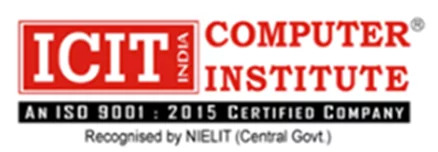
6. ICIT Computer Institute is one of the leading software training companies in India, offering comprehensive IT courses and cutting-edge training programs to IT aspirants [students & individuals], working professionals, corporates, institutions and government entities.

7. EduPristine is one of India’s leading training providers in Analytics, Accounting, Finance, Healthcare, and Marketing. Founded in 2008, EduPristine has a strong online platform and network of classrooms across India and caters to self-paced learning and online learning, in addition to classroom learning.

8. IIM Skills is another institute providing digital marketing courses in Bandra that provides online courses in different digital domains.
They provided real-time projects to ensure that they became well-trained for the digital industry. The institute offers a comprehensive course in digital marketing

9. Digital Vidya- The Digital Marketing Online Course at Digital Vidya offers a valuable learning experience through its hands-on assignments. These assignments are divided into module and case study tasks, which make the course more practical and engaging.
10. IDCM is India’s top-ranked vocational Training Institute, skilling 2 Lakh+ students annually. This course is designed for both freshers and working professionals who want to excel in their digital marketing careers. It is a classroom-based training program.
Exploring the Digital Marketing Course Fees in Mumbai:

Understanding the financial aspect is crucial. The digital marketing course fees in Mumbai vary across institutes. However, institutes like AADME offer value-driven courses without compromising quality.
Finding the Best Digital Marketing Institute in Mumbai with Placement:

Securing a placement after completing a course is a priority for many. Institutes like DMTI and AADME boast excellent placement records, forging lucrative career paths for their graduates.
Unveiling the Best Institute for Digital Marketing Course in Mumbai:
While each institute has its unique offerings, the 'best' institute depends on individual preferences. Factors like curriculum, faculty, industry connections, and alumni success stories play pivotal roles.
Empowering Your Digital Marketing Journey:

Now that you're equipped with insights into the top digital marketing courses in Bandra, Mumbai, it's time to leap! Choosing the right course can transform your career trajectory in the digital sphere.
Ready to delve deeper into the world of digital marketing in Bandra, Mumbai?
Explore our comprehensive guide to choosing the best digital marketing courses in Bandra tailored to your needs!
#digital marketing#best digital marketing courses in Mumbai#digital marketing courses in Bandra#digital marketing course fees Mumbai#digital marketing classes in Mumbai#best digital marketing institute in Mumbai with placement#best digital marketing training institute in Mumbai#best institute for digital marketing course in Mumbai
2 notes
·
View notes
Text
In Costa Rica and Latvia today, the Atlantic Council is hosting its 360/OS Summit at RightsCon Costa Rica and NATO’s Riga StratCom. Among other things, the influential think tank will be previewing its “Task Force for a Trustworthy Future Web” report, which they hope will “lay the groundwork for stronger cross-sectoral ideation and action” and “facilitate collaboration now between the expanding community dedicated to understanding and protecting trust and safety.”
In human terms, conference attendees are discussing how best to stay on-brand by presenting the Censorship-Industrial Complex as a human rights initiative, and as #TwitterFiles documents show, they have the juice to pull it off.
EngageMedia (which I co-founded and was the long-time Executive Director) co-organized RightsCon in Manila in 2015, and I personally oversaw a lot of the preparations. That looks like a big mistake. I now believe RightsCon represents everything that has gone wrong in the digital rights field. Specifically, it represents the capture of a once-vibrant movement by corporate and government interests, and a broader shift towards anti-liberal and authoritarian solutions to online challenges. I left EngageMedia on good terms, but now have no formal relationship.
In honor of this week’s RightsCon and 360/OS Summit, we dug into the #TwitterFiles to revisit the integration of the Atlantic Council’s anti-disinformation arm, the Digital Forensic Research Labs (DFRLab), while also highlighting its relationship with weapons manufacturers, Big Oil, Big Tech, and others who fund the NATO-aligned think tank.
The Atlantic Council is unique among “non-governmental” organizations thanks to its lavish support from governments and the energy, finance, and weapons sectors. It’s been a key player in the development of the “anti-disinformation” sector from the beginning. It wasn’t an accident when its DFRLab was chosen in 2018 to help Facebook “monitor for misinformation and foreign interference,” after the platform came under intense congressional scrutiny as a supposed unwitting participant in a Russian influence campaign. Press uniformly described DFRLab as an independent actor that would merely “improve security,” and it was left to media watchdog FAIR to point out that the Council was and is “dead center in what former President Obama’s deputy national security advisor Ben Rhodes called ‘the blob.’”
What’s “the blob”? FAIR described it as “Washington’s bipartisan foreign-policy consensus,” but thanks to the Twitter Files, we can give a more comprehensive portrait. In the runup to the 360/OS event in that same year, 2018, Graham Brookie of the Atlantic Council boasted to Twitter executives that the attendees would include the crème de la crème of international influence, people he explained resided at the “no-kidding decision-maker level”:
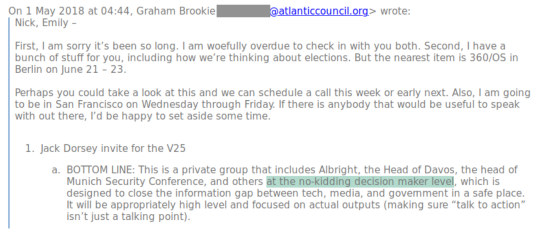
Similar correspondence to and from DFRLab and Twitter outlined early efforts to bring together as partners groups that traditionally served as watchdogs of one another. Perhaps more even than the World Economic Forum meetings at Davos or gatherings of the Aspen Institute in the US, the Atlantic Council 360/OS confabs are as expansive a portrait of the Censorship-Industrial Complex as we’ve found collected in one place.
In October 2018, DFRLab was instrumental in helping Facebook identify accounts for what became known as “the purge,” a first set of deletions of sites accused of “coordinated inauthentic behavior.” Facebook in its announcement of these removals said it was taking steps against accounts created to “stir up political debate,” and the October 2018 “purge” indeed included the likes of Punk Rock Libertarians, Cop Block, and Right Wing News, among others. Even the progressive Reverb Press, founded by a relatively mainstream progressive named James Reader, found his site zapped after years of pouring thousands of dollars a month into Facebook marketing tools. “That’s what sticks in my craw. We tried to do everything they suggested,” Reader said then. “But now, everything I worked for all those years is dead.”
In the years since, DFRLab has become the central coordination node in the Censorship Industrial Complex as well as a key protagonist in the Election Integrity Partnership and the Virality Project. Its high-profile role at RightsCon, the biggest civil society digital rights event on the calendar, should concern human rights and free expression activists.
According to their London 2019 event “360/OS brings together journalists, activists, innovators, and leaders from around the world as part of our grassroots digital solidarity movement fighting for objective truth as a foundation of democracy.” Their Digital Sherlocks program aims to “identify, expose, and explain disinformation.” But DRFLabs are more Inspector Gadget (or double agents) than Sherlock Holmes. The Twitter Files reveal DFRLab labeled as “disinformation” content that often turned out to be correct, that they participated in disinformation campaigns and the suppression of “true” information, and that they lead the coordination of a host of actors who do the same.
Twitter Files #17 showed how DFRLab sent Twitter more than 40,000 names of alleged BJP (India’s ruling nationalist party) accounts that they suggested be taken down. DFRLab said it suspected these were “paid employees or possibly volunteers.” However as Racket’s Matt Taibbi noted, “the list was full of ordinary Americans, many with no connection to India and no clue about Indian politics.” Twitter recognized there was little illegitimate about them, resulting in DFRLab pulling the project and cutting ties with the researcher.
Twitter Files #19 further revealed DFRLab was a core partner in the Election Integrity Partnership (EIP), which “came together in June of 2020 at the encouragement of the U.S. Department of Homeland Security’s Cybersecurity and Infrastructure Security Agency, or CISA” in order to “fill the gaps legally” that government couldn’t. As a result, there are serious questions as to whether the EIP violated the US First Amendment.
DFRLab was also a core partner on the Virality Project, which pushed its seven Big Tech partners to censor “stories of true vaccine side-effects.” The Stanford Internet Observatory, which led the project, is now being sued by the New Civil Liberties Alliance for its censorship of “online support groups catering to those injured by Covid vaccines.” Debate as to the frequency of serious adverse events is ongoing, however. The German health minister put it at 1 in 10,000, while others claim it is higher.
The Virality Project sought to suppress any public safety signals at all. The Stanford Internet Observatory is also at the moment reportedly resisting a House Judiciary Committee subpoena into its activities.
TwitterFiles #20 revealed some of the Digital Forensic Lab’s 2018 360/0S events, which brought together military leaders, human rights organizations, the Huffington Post, Facebook and Twitter, Edelman (the world’s biggest PR firm), the head of the Munich Security Conference, the head of the World Economic Forum (Borge Brende) a former President, Prime Minister and CIA head, intel front BellingCat and future Nobel Peace Prize winner Maria Ressa, all to combat “disinformation.” We can now reveal more.
Introducing the Atlantic Council
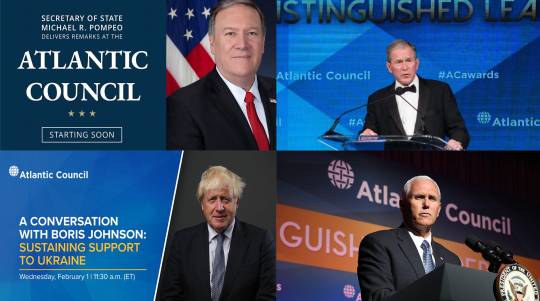
The Atlantic Council is a NATO-aligned think tank established in 1961. Its board of directors and advisory board are a Who’s Who of corporate, intelligence and military power, including:
James Clapper – former Director of National Intelligence whose tenure included overseeing the NSA during the time of the Snowden leaks. Asked whether intelligence officials collect data on Americans Clapper responded “No, sir,” and, “Not wittingly.” Clapper also coordinated intelligence community activity through the early stages of Russiagate, and his office authored a key January 2017 report concluding that Russians interfered in 2016 to help Donald Trump. Clapper has been a 360/OS attendee.
Stephen Hadley, United States National Security Advisor from 2005 to 2009 (also a 360/OS attendee)
Henry Kissinger, former US Secretary of State who oversaw the carpet bombing of Vietnam, among other crimes against humanity
Pfizer CEO Anthony Bourla
Stephen A. Schwarzman, Chairman, CEO, and Co-Founder, The Blackstone Group
Meta’s President for Global Affairs, Nick Clegg
Richard Edelman, CEO of the world’s largest PR firm (and 360/OS attendee)
The Rt. Hon. Lord Robertson of Port Ellen, Former Secretary General of NATO
Ambassador Robert B. Zoellick, Former President of the World Bank
Leon Panetta, former US Secretary of Defense & CIA Director. Panetta oversaw the US’s massive growth in drone strikes.
John F. W. Rogers. Goldman Sachs Secretary of the Board
Chuck Hagel, chairman of the Council, sits on the board of Chevron and is also a former US Secretary of Defence.
The Atlantic Council raised $70 million in 2022, $25 million of which came from corporate interests. Among the biggest donors were: the US Departments of Defense State, Goldman Sachs, the Rockefeller Foundation, Craigslist founder Craig Newmark, Google, Crescent Petroleum, Chevron, Lockheed Martin, General Atomics, Meta, Blackstone, Apple, BP, eBay founder Pierre Omidyar, Raytheon, ExxonMobil, Shell, Twitter, and many more. Ukraine’s scandal-ridden energy company, Burisma, whose links to Hunter Biden were suppressed by the August 2020 table-top exercise coordinated by the Aspen Institute, also made a contribution. You can view the full 2022 “honor roll” by clicking here.
The Atlantic Council is the Establishment, though many suffer from the delusion that in putting on a “Digital Sherlock” cape, they’re somehow with the rebel alliance. The opposite is true. The Atlantic Council and DFRLab don’t hide their militarist affiliations. This week’s OS/360 event at RightsCon Costa Rica runs together with a 360/OS at NATO’s Riga StratCom Dialogue, which DFRLab note they have “worked closely with” “since 2016.”
The Birth of the Digital Forensic Research Lab
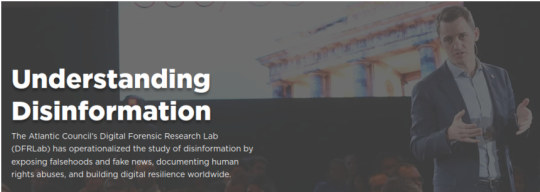
DFRLab was founded in 2016, and has been a major catalyst in expanding the “anti-disinformation” industry. Among non-governmental entities, perhaps only the Aspen Institute comes close to matching the scope, scale and funding power of DFRLab. DFRLab claims to chart “the evolution of disinformation and other online and technological harms, especially as they relate to the DFRLab’s leadership role in establishing shared definitions, frameworks, and mitigation practices.”
Almost $7 million of the Atlantic Council’s $61 million spent last year went to the DRFLabs, according to their 2022 annual financial report. Through its fellowship program, it has incubated leading figures in the “disinformation” field. Richard Stengel, the first director of the Global Engagement Center (GEC), was a fellow. GEC is an interagency group “within” the State Department (also a funder of the Atlantic Council), whose initial partners included the FBI, DHS, NSA, CIA, DARPA, Special Operations Command (SOCOM), and others. GEC is now a major funder of DFRLab and a frequent partner:
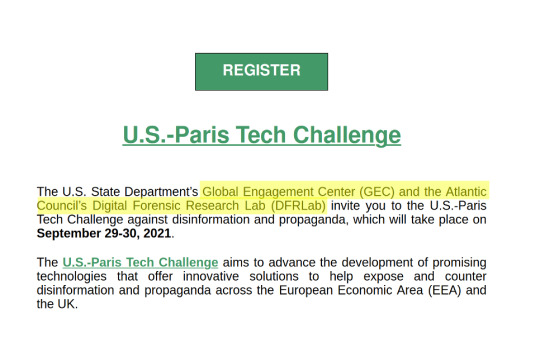
In this video, Stengel says, “I’m not against propaganda. Every country does it, they have to do it to their own population, and I don’t think it’s that awful.”
Stengel was true to his word, and apart from DFRLab, the GEC funded the Global Disinformation Index, which set out to demonetize conservative media outlets it claimed were “disinformation.” (See 37. in the censorship list) He thought the now-disgraced Hamilton68 was “fantastic.” In total, GEC funded 39 organizations in 2017. Despite Freedom of Information requests, only 3 have been made public to date. Roughly $78 million of GEC’s initial $100 million budget outlay for fiscal year 2017 came from the Pentagon, though the budgetary burden has shifted more toward the State Department in the years since.
The Global Engagement Center was established in the last year of Barack Obama’s presidency, via a combination of an executive order and a bipartisan congressional appropriation, led by Ohio Republican Rob Portman and Connecticut Democrat Chris Murphy. The GEC was and remains virtually unknown, but reporting in the Twitter Files and by outlets like the Washington Examiner have revealed it to be a significant financial and logistical supporter of “anti-disinformation” causes.
Though tasked by Obama with countering “foreign state and non-state propaganda and disinformation efforts aimed at undermining United States national security interests,” its money has repeatedly worked its way back in the direction of policing domestic content, with Gabe Kaminsky’s Examiner reports on the GDI providing the most graphic example.
GEC frequently sent lists of “disinformation agents to Twitter.” Yoel Roth, former head of Trust and Safety referred to one list as a “total crock.” Roth is now a member of DFRLab’s Task Force for a Trustworthy Future Web. Let’s hope he brings more trust than Stengel. You can read more on GEC’s funding here.
Other DFRLab luminaries include Simon Clark, Chairman of the Center for Countering Digital Hate (a UK “anti-disinformation” outfit that aggressively deplatforms dissidents), Ben Nimmo (previously a NATO press officer, then of Graphika (EIP and the Virality Project partners) and now Facebook’s Global Threat Intelligence Lead), and Eliot Higgins of Bellingcat. Bellingcat has an ominous reputation, which it’s earned in numerous ways, including its funding by the National Endowment for Democracy (see Glenn Greenwald’s recent report and Aaron Maté’s here). Most recently, Bellingcat assisted in the arrest of the 21-year-old Pentagon leaker, further speeding up the abandonment of the Pentagon Papers Principal where the media protected, rather than persecuted, leakers. Bellingcat was part of 360/OS backroom meetings with former intel chiefs, the head of Davos and the Munich security conference among many others, as we will see soon.
As noted in the introduction, DFRLab itself has made several wrong calls on “disinformation.” In one report they highlighted “outright false narratives,” which focused mainly on the notion that Covid was an engineered bioweapon, but lumped in the “unverified” claim Covid was the “result of a lab accident.” A lab accident is now the preferred hypothesis of the US Department of Energy, the FBI, and many others. To the DFRLab it was “disinformation” and a “conspiracy theory.”
The Election Integrity Partnership and the Virality Project
DFRLab were core partners on two of the most influential “anti-disinformation” initiatives of recent times.
The Virality Project built on the EIP and had partnerships with Twitter, Facebook, Instagram, Youtube, Google, TikTok and more to combat vaccine “misinformation.” Stanford and DFRLab partnered with the University of Washington’s Center for an Informed Public, Graphika, NYU Tandon School of Engineering and Center for Social Media and Politics, and the National Congress on Citizenship. Through a shared Jira ticketing system they connected these Big Tech platforms together, with Graphika using sophisticated AI to surveil the online conversation at scale in order to catch “misinformation” troublemakers.
VP went far beyond any kind of misinformation remit, most infamously recommending to their Big Tech partners that they consider “true stories of vaccine side effects” as “standard misinformation on your platform.”

A Virality Project partner called the Algorithmic Transparency Initiative (a project of the National Congress on Citizenship) went further. Their Junkipedia initiative sought to address “problematic content” via the “automated collection of data” from “closed messaging apps,” and by building a Stasi-like “civic listening corps,” which in recent years has taken on a truly sinister-sounding mission. The current incarnation might as well be called “SnitchCorps,” as “volunteers have an opportunity to join a guided monitoring shift to actively participate in monitoring topics that disrupt communities”:
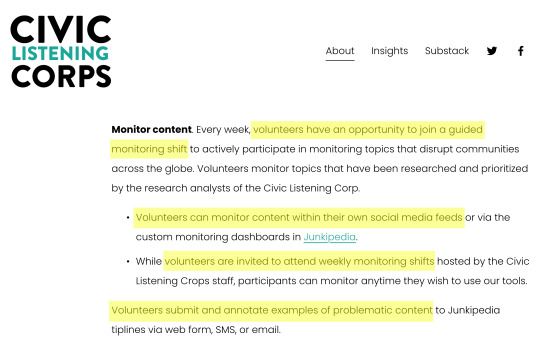
Garret Graff, who oversaw the Aspen Hunter Biden table-top exercise, was chairman of that same National Congress on Citizenship when they collaborated on the Virality Project. Both EIP and VP were led by Renee DiResta of the Stanford Internet Observatory, a former CIA fellow who engineered the now disgraced New Knowledge initiative, which developed fake Russian bots to discredit a 2016 Alabama senate race candidate, as acknowledged by the Washington Post. You can read Racket’s previous work on the Virality Project here.
DFRLab are the elite of the “anti-disinformation” elite. They work closely with a wide range of actors who have participated in actual disinformation initiatives. Here they’re invited to an elite Twitter group set up by Nick Pickles of “anti-disinformation” luminaries First Draft, also participants in the Hunter Biden laptop tabletop, and the Alliance for Security Democracy, part of the RussiaGate Hamilton68 disinformation operation.
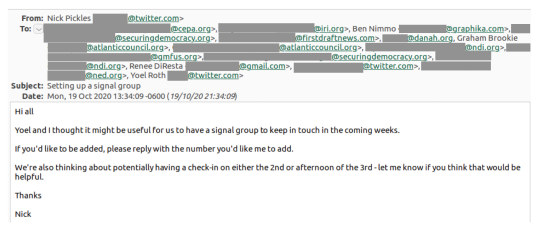
360/OS
The 360/OS event marries this tarnished record with the financial, political, military, NGO, academic and intelligence elite. Some of this is visible through publicly available materials. Twitter Files however reveal the behind the scenes, including closed door, off-the-record meetings.
“I’ve just arrived in Kyiv” Brookie notes in 2017, as he seeks to line up a meeting with Public Policy Director Nick Pickles as they discuss Twitter providing a USD $150K contribution to OS/360 (seemingly secured), and to garner high level Twitter participation.
Pickles is visiting DC and Brookie suggests he also meet with the GEC and former FBI agent Clint Watts of Hamilton 68 renown. “Happy to make those connections,” he chimes.
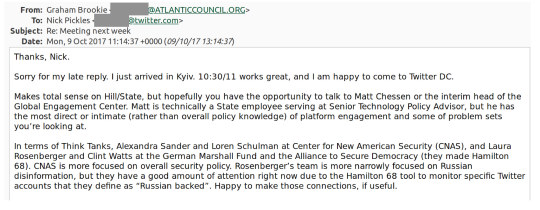
360/OS events are elite and expensive — $1 million according to Brookie — so closer collaboration with Twitter, especially in the form of funding, is a high priority.

Twitter offers $150,000:
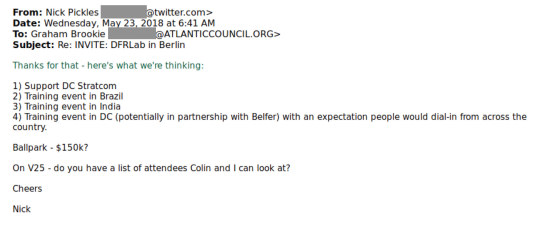
When Brookie mentions the attendees at the “no-kidding decision maker level” he isn’t kidding. Parallel to the 360/OS public program is the much more important off-the-record meeting of “decision makers ranging from the C-Suite to the Situation Room.” Here, he is explicit about a convening of military and financial power. Vanguard 25 is presented as a way to ���create a discreet and honest way to close the information gap on challenges like disinformation between key decision makers from government, tech, and media.”

The document boasts of its high-level participants:

More are revealed in email exchanges, including Madeleine Albright and the head of the WEF:

They go on to list a bizarre mishmash of media leaders, intelligence officials, and current or former heads of state:

It appears Germany’s Angela Merkel was out of reach in the end, but many of the others attended this behind the scenes meeting on “disinformation.” Who are they?
Matthias Dopfner – CEO and 22% owner of German media empire Axel Springer SE, the biggest media publishing firm in Europe
Borge Brende – head of the World Economic Forum and former Norwegian foreign minister
Toomas Hendrick Ilves – former President of Estonia who co-chairs the World Economic Forum’s Global Futures Council on Blockchain Technology. Hendrick is also a fellow at the Freeman Spogli Institute for International Studies (where the Stanford Internet Observatory is housed) and is on the advisory council of the Alliance for Securing Democracy, of Hamilton 68 renown.
Chris Sacca – billionaire venture capitalist
Mounir Mahjoubi – previously Digital Manager for President Macron’s presidential campaign, and former Chairman of the French Digital Council
Reid Hoffman – billionaire and Linkedin co-founder
Ev Williams – Former CEO of Twitter and on the Twitter board at the time
Kara Swisher – New York Times opinion writer, who founded Vox Media Recode
Wolfgang Ischinger - Head of the Munich Security Conference
Aleksander Kwasniewski – Former President of Poland. Led Poland into NATO and the EU.
Richard Edelman – CEO of the largest PR company in the world
Elliot Shrage – previously Vice-President of Public Policy at Facebook (DFRLab had election integrity projects with Facebook)
Lydia Polgreen – Huffington Post Editor in Chief
Jim Clapper – former US Director of National Intelligence
Maria Ressa – co-founder of Rappler and soon to be winner of the Nobel Peace Prize
JK Rowling was also invited to give an award, though appears she didn’t make it in the end:

Why would such a group all gather specifically around the question of “disinformation”? Is disinformation truly at such a level that it requires bringing together the world’s most popular author with military and intelligence leaders, the world’s biggest PR company, journalists, billionaires, Big Tech and more? Or is this work to build the case that there is a disinformation crisis, to then justify the creation of a massive infrastructure for censorship? A glimpse of the agenda offers clues:

Here the head of the most important military and intelligence conference in the world (Munich) sits down in a closed door meeting with a former Secretary of State and the Executive Vice-Chair of the Atlantic Council.

Which is followed by a closed door session with the Editor-in Chief of the now-defunct Huffington Post and peace-maker Maria Ressa who presented to the same group of military, intelligence, corporate and other elites. Is the role of a journalist and Nobel laureate to work behind closed doors with militarists and billionaires, or to hold them to account?
At 2022’s OS/360 at RightsCon Ressa conducted a softball interview on disinformation with current US Secretary of State Anthony Blinken. In testimony last April 2023, former CIA deputy director Michael Morrell stated that Blinken “set in motion the events that led to the issuance of the public statement” by more than 50 former intelligence officials that the Hunter Biden laptop had “all the classic earmarks of a Russia information operation.”
The Twitter Files also revealed that in August 2020 the Aspen Institute organized a table-top exercise to practice how best to respond to a “hack and leak” of a Hunter Biden laptop. The laptop only came to light however two months later. In attendance was First Draft (now the Information Futures Lab), the New York Times, Washington Post, Rolling Stone, CNN, Yahoo! News, Facebook, Twitter and more. Here, DFRLab head Graham Brookie speaks with the Aspen Institute’s Garret Graff, who coordinated the Hunter Biden tabletop exercise.
After it turned out the Hunter Biden laptop was real, and the disinformation operation was more appropriately described as having been led by the likes of Blinken and the Aspen Institute. The appropriate response is apparently for RightsCon, DFRLab, Blinken and Ressa to put on a nice forum to promote these figures as “anti-disinformation” leaders.
youtube
Former DFRLab fellow and intel front Bellingcat founder Eliot Higgins is also invited to the closed door sessions with a former head of the CIA, a former Prime Minister and a President. How do you keep power accountable when you are in the same cozy club? This theme runs throughout. Bellingcat is featured heavily at the public sessions also:
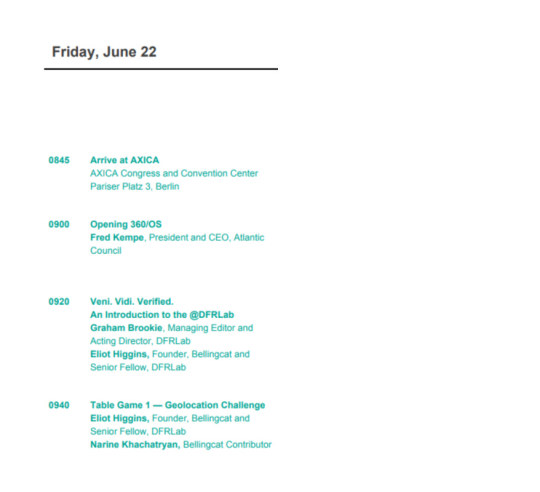
Higgins has a unique way of expressing himself online, given the DFRLab emphasis on striking out against divisiveness:
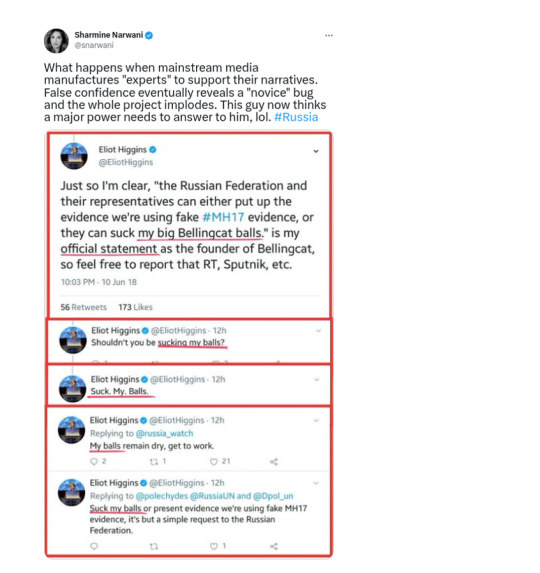
Would this pass RightsCon’s code of conduct? If not, he appears to be good enough for DFRLab to promote.
On the public side, we see Amnesty International participating to further collapse the distinction between those who are meant to hold power to account, and the powerful themselves. The Iraq war gave us embedded journalists, and the “anti-disinformation” field gives us embedded digital rights activists.

The Department of Homeland Security’s Chris Krebs also joined the closed door session. Krebs was Co-Chair of the Aspen Institute’s Commission on Information Disorder. Other members included Prince Harry, the Virality Project’s Alex Stamos (Stanford Internet Observatory) and Kate Starbird (University of Washington and previous 360/OS participant), Katie Couric, and more. Craig Newmark attended as an observer.

Meanwhile Renee DiResta, former CIA fellow and Stanford Internet Observatory Research Director, presented with the former Prime Minister of Sweden. This was years before she would launch the Virality Project, and take on the bugbear of “true stories of vaccine side effects.”

The President of the Atlantic Council participated in an “off-the-record, “ behind closed doors conversation on “trust” with the CEO of the world’s biggest PR firm, Edelman.
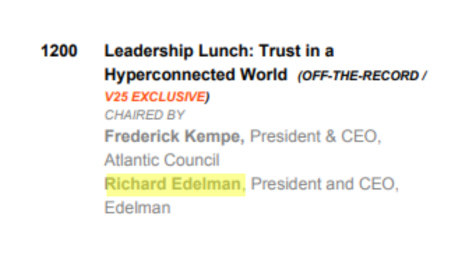
“Public relations” and “trust” may well be opposites, and trust is being destroyed not by the disinformation street crime that these groups claim to target, but by the disinformation corporate crime protected by, or in some cases created by these same people. Disinformation is real, but its biggest purveyors are governments and powerful corporate interests.
DFRLab and RightsCon show just how far the capture of civil society by elite interests has come. Again, I made a mistake helping to co-organize RightsCon in 2015. The jumping in bed with the government and Big Tech was arguably there in 2015, though to a much lesser degree. It now partners with militarists in the form of the Atlantic Council and is an enabler of the “disinformation” grift that is so deeply impacting freedom of speech and expression.
The air-gaps that should separate civil society, media, military, billionaires, intelligence and government have collapsed, and many of these actors have formed a new alliance to advance their shared interests. If weapons manufacturers funding human rights is considered legitimate then where is the red line? Effectively, there is none.
This collapse however has also been pushed by funders, who have been proactive in asking NGOs to collaborate more with Big Tech and government - something I successfully resisted for my almost 18 years at EngageMedia, critically RightsCon was the only time I let my guard down.
The RightsCon sponsor matrix wouldn’t be out of place at NASCAR:
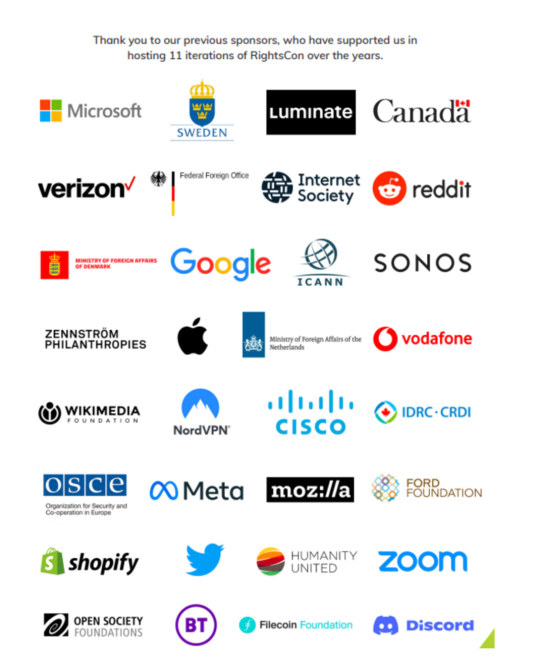
This is the equivalent of hosting a Climate Change conference sponsored by Shell, BP, Chevron, and ExxonMobil. How do you keep power accountable when Big Tech pays your wage? The “let’s all work together” approach has failed. The weakest partner, civil society, got captured and we lost. Many more lost their way and have acquiesced to and often enabled much of the new censorship regime.
A renewed and much more independent digital rights movement, with a strong commitment to freedom of expression, is well overdue.
Note: A previous version of this article mistook Blackstone for Blackwater. This has been corrected.
#rightscon#360/OS#twitter#twitter files#censorship#digital censorship#internet censorship#censorship industrial complex#atlantic council#DFRLAB#covid vaccines#virality project#NATO#propaganda#global engagement center#bellingcat#civic listening corps#world economic forum#stanford internet observatory#big tech#hunter biden#aspen institute#amnesty international#Youtube
2 notes
·
View notes
Text
Warning Signs of Societal Instability: A Checklist
This checklist identifies key markers of different forms of societal breakdown, using historical references—primarily from Nazi Germany—to highlight patterns of authoritarian control, economic collapse, and societal fragmentation.
Economic Breakdown:
Rapid inflation making basic necessities unaffordable (Weimar Republic, 1921-1923—hyperinflation led to economic despair, paving the way for instability)
Frequent bank closures, fund access restrictions, or mass withdrawals (Germany, 1931—banking crisis destabilized the economy, increasing desperation)
High unemployment rates and widespread job insecurity (Germany, early 1930s—mass unemployment led to Nazi economic policies)
Rise in black market activity and barter economies (WWII Germany—rationing and resource scarcity fueled underground economies)
Increasing homelessness and food insecurity (Great Depression, 1929-1933—economic hardship led to mass displacement, radical political shifts)
Government printing excessive money with no economic backing (Weimar Republic, 1921-1923—hyperinflation wiped out savings and trust in currency)
Stock market volatility leading to panic sells and crashes (1929 Great Depression—instability spread globally, contributing to political upheaval)
Frequent supply chain disruptions causing product shortages (WWII-era Germany—resource mismanagement and war efforts led to severe shortages)
State-controlled corporations consolidating economic power (Germany, 1930s—Nazi-backed industries like Krupp and IG Farben dominated)
Drastic increase in public or personal debt burdens (Weimar Republic—Versailles Treaty reparations and economic collapse pushed citizens into financial despair)
Transition to Autocracy or Dictatorship:
Concentration of power in a single leader or small group (Hitler’s rise, 1933—Enabling Act granted total power to a single individual)
Political opposition being jailed, silenced, or exiled (Germany, 1933—Reichstag Fire Decree suppressed political opposition; 1934 Night of the Long Knives eliminated rivals within Nazi ranks)
Elections becoming controlled, rigged, or eliminated (Germany, 1933—intimidation, suppression, and violence ensured Nazi dominance)
Dissolution of checks and balances (courts, legislatures lose power) (Reichstag Fire Decree, 1933—suspended constitutional protections)
Military increasingly involved in domestic politics (Germany, 1934—military pledged loyalty to Hitler instead of the state)
Declining civil liberties, including the right to protest (Germany, 1933—banned political dissent, suppressed workers' movements)
Open talk of ending democratic institutions (Hitler's speeches—framed dictatorship as necessary for national security)
Increase in nationalist or cult-like leader worship (Germany, 1930s—mass propaganda, "Führer" worship spread through society)
Purges within government institutions of non-loyalists (Germany, 1933—civil servants, judges, teachers forced to pledge Nazi loyalty)
Increase in emergency powers used without end (Germany, 1933-1945—continuous state of emergency justified indefinite rule)
Censorship & Information Control
Mass de-platforming or banning of opposition figures (Germany, 1933—journalists, academics, and dissenters expelled or arrested)
Government-controlled media and elimination of independent journalism (Germany, 1933—Editors' Law placed press under Nazi control)
"Disinformation laws" used to suppress dissenting views (Germany, 1934—laws against "subversive" speech criminalized political opposition)
Internet blackouts, social media restrictions, or digital surveillance laws (Modern parallel—China’s "Great Firewall"; Germany used censorship of radio and print)
Textbook or historical revisionism to promote an official narrative (Germany, mid-1930s—curricula rewritten to align with Nazi ideology)
Punishments for sharing alternative viewpoints online or in print (Germany, 1930s—severe penalties for anti-Nazi literature)
Schools and universities pressured to enforce political ideology (Germany, 1930s—teachers required to join Nazi-aligned education leagues)
Manipulation of search results and AI-driven news curation (Modern parallel propaganda-driven search results in autocratic regimes)
Public fear of discussing certain topics openly (Germany, 1930s—Gestapo informants encouraged denunciations)
Forced loyalty pledges or ideological compliance tests (Germany, late 1930s—Nazi Party membership increasingly required for career advancement)
Surveillance & Police State Expansion:
Expansion of domestic spying programs and data collection (Gestapo, 1930s—state surveillance and informant networks controlled civilians)
Increased use of facial recognition, biometric tracking, and digital IDs (Modern parallel—China’s AI surveillance; Nazi identity papers controlled movement)
Growth of secret police or paramilitary enforcement groups (Germany, 1930s—Gestapo and SS enforced state control)
"Pre-crime" policies and punishment for suspected intent rather than actions (Germany, 1930s—arrests made for perceived political unreliability)
Dissidents being targeted through financial restrictions (Germany, 1933—Jews and political dissidents lost economic rights, businesses seized)
Rise in anonymous informants and reward systems for reporting non-conformity (Germany, 1930s—neighbors and even children reported suspected dissenters)
Social credit-style systems limiting access to goods or services (Germany, 1930s—"undesirables" faced restrictions on food, jobs, and housing)
Expansion of AI monitoring in private life (smart homes, workplace tracking) (Modern parallel—China's AI-powered monitoring of citizens)
Public surveillance cameras integrated with real-time government monitoring (Germany, 1930s—intense monitoring by Gestapo and local spies)
Laws enabling indefinite detention or prosecution without trial (Germany, 1933—Reichstag Fire Decree allowed indefinite detention of political prisoners)
0 notes
Text
Dubai as the business hub of the world is a place where companies fight every single day to be seen on the web. The incredible speed of technology development and the rise of digital platforms make us look at the concept of the Best Digital Marketing Company in a completely different way—we are forced to realize that it is not an option but a basic need. A well-chosen marketing agency can help your brand grow, extend your reach, and gain a better ROI. However, what are the characteristics of the company you consider the best? Let's discover in this article.
The Growing Need for Digital Marketing in Dubai
Dubai is a center where the most luxurious items, technology, and business gather. Digital marketing will be the difference between success and being a failed experiment that you may witness with your startup, SME, or a corporate giant. The most severe competition has started in response to the increasing number of businesses that have gone online. That’s why the Best of the Best Digital Marketing Company in Dubai are here for—to plan such strategies that are based on data and fit in your company.
Key Services Offered by a Top Digital Marketing Company
The major tasks of a trustworthy digital marketing stipulate the provision of diverse services that will help your business to stand out and engage more clients. Here is a listing of features that you are bound to find in the Best Digital Marketing Company in Dubai:
SEO (Search Engine Optimization): Your business will not be found on Google unless you rank high in the search engine, that’s why SEO is of utmost importance.
PPC (Pay-Per-Click Advertising): A thought out ad campaign is a guarantee for an immediate effect on your brand and leads. Social Media Marketing: Given the fact that Dubai has a high social media engagement, an effective strategy across the platforms should be implemented, including Instagram, LinkedIn, and TikTok, among others.
Content Marketing: The best quality of content is not only what engages the audience but also what creates trust between you and the customers.
Web Development & Design: Your website is the first impression people get about your brand. A fully-bodied, visually captivating website can help turn visitors into customers.
Email & Influencer Marketing: Personalized email ads and tie-ups with influencers provide you with a chance to get your brand noticed by more people
Why Dubai-Based Companies Need the Best Digital Marketing Services
Dubai is the home to multi-economic activities between different nations, therefore the competition is high. To be on the top of the industry, selecting the Best Digital Marketing Company in Dubai is the first step to get the deserved visibility of your brand. The following are the reasons that will help you to understand the importance of it:
Targeting the Right Audience – Dubai’s market is diverse. A good agency will help you target the right demographics that you are interested in.
Localized Strategies – Behavior, beliefs, and search trends in the area at the point of purchase are very important at this point.
Staying Ahead of Competitors – Only excellent digital marketing companies can guide you through the times of ferocious competition and still have you at the top with evolving strategies.
How to Choose the Best Digital Marketing Company in Dubai
Purposeful selection of the Best Digital Marketing Company in Dubai is a method that involves a search process and a knowledge of aims and objectives. The below are several things to think about:
Experience & Portfolio: Look for case studies and customer testimonials.
Customization: Not all strategies that work on others will work on you. A digital marketing company should be able to develop strategies specific to your business.
Transparency: A good vendor will deliver a detailed campaign report.
Innovative Approach: The market in Dubai changes so fast that about 60% of the companies are upstaging one another.
Conclusion:
Today’s business environment is so dynamic that digital marketing is no longer just about visibility but also about authority. With the Best Digital Marketing Company in Dubai, your business will continue to grow, quality traffic will increase, and conversions will go through the ceiling. No matter whether you are a small local firm or an international brand planning to expand in the UAE, the right digital marketing agency is the key to your success. Are you ready to be the Champion of Your Brand? Choose Big today, and digital success will follow you!
0 notes
Text
osCommerce Development Company in New York
LDS Engineers is the best OsCommerce Development Company in New York, USA. Are you seeking dependable and expert oscommerce development services in New York? Look no in addition to LDS Engineers! We are a main osCommerce improvement agency supplying fantastic services to corporations throughout the globe. Whether you're within the US, UK, India, Australia, or anywhere else, we supply pinnacle-notch eCommerce solutions tailor-made for your specific wishes.

At LDS Engineers, we apprehend that every commercial enterprise is exclusive. That’s why our team of skilled osCommerce developers is dedicated to building customized eCommerce structures that fit your precise goals. With years of expertise in osCommerce development, we've helped infinite agencies create online stores that are not only simplest and practical but also visually attractive and clean to use.
Why Choose LDS Engineers for osCommerce Development?
Expert Team of Developers
Our team of skilled osCommerce builders has good sized enjoy in creating tailor-made eCommerce solutions. We specialize in customizing osCommerce structures, integrating advanced functionalities, and optimizing databases to ensure high overall performance and scalability.
Cost-Effective Services
We pride ourselves on providing lower-priced osCommerce development offerings without compromising the best. We intend to assist companies of all sizes in constructing their online presence in a fee-green manner.
Global Reach
LDS Engineers is a relied-on name in osCommerce development, imparting services internationally. We have added successful tasks to customers in nations just as the US, UK, India, Australia, and more.
Timely Delivery
Time is of the essence, specifically inside the speedy-paced eCommerce global. We ensure that each one of our projects is brought on time so you can launch your online shop and start attracting customers fast.
Ongoing Support and Maintenance
Our courting with our clients doesn’t cease after the undertaking is delivered. We offer continuous aid and protection to maintain your osCommerce keeps strolling easily. From upgrading to the trendy model to including new features, we’re here to help every step of the manner.
What We Offer
Custom osCommerce Development
Whether you’re starting from scratch or looking to revamp a present keep, our group can construct a completely custom-designed eCommerce platform tailored to your commercial enterprise needs.
OsCommerce Customization
Want to feature particular functions or improve your store's capability? We can personalize your osCommerce platform to include everything from advanced price gateways to user-pleasant navigation and greater.
Upgrades and Migration
Stay in advance of the opposition via upgrading to the modern osCommerce version. We make certain a continuing migration procedure without any statistics loss or downtime.
Module Integration
Enhance your keep’s functionality with 1/3-celebration module integrations. We can add functions like inventory management, analytics, SEO gear, and more to boost your enterprise.
Maintenance and Support
We offer round-the-clock aid to make sure your save operates smoothly. Our team is continually equipped to assist you with any technical problems or updates.
Why osCommerce?
OsCommerce is one of the maximum famous open-supply eCommerce systems, trusted with the aid of businesses worldwide for its flexibility, scalability, and significant capabilities. It allows organizations to create powerful online stores that are smooth to control and personalize. With osCommerce, you could offer a seamless purchasing experience to your clients, boosting income and patron pleasure.
Partner with LDS Engineers
At LDS Engineers, our project is to help corporations grow by way of providing super osCommerce development offerings. We combine our technical understanding with a purchaser-centered technique to deliver answers that exceed expectations. Whether you need a brand new eCommerce save, customization, or ongoing assistance, we’re right here to make your vision a reality.
Get in contact with LDS Engineers today to study more approximately how we assist you to prevail within the competitive eCommerce international. Let’s build something exceptional together!
oscommerce development, oscommerce development services, top oscommerce development, oscommerce development in us, oscommerce development in India, oscommerce development company.
#oscommerce development#oscommerce development services#top oscommerce development#oscommerce development in us#oscommerce development in india#oscommerce developement company
0 notes
Text
Comprehensive Web Designing Services in Faridabad by Fixdot Technologies
Web Designing Services in Faridabad

Fixdot Technologies is a leading provider of web designing services in Faridabad, offering creative and user-friendly solutions to help businesses establish a strong online presence. We specialize in crafting visually appealing and highly functional websites that resonate with your brand and engage your target audience.
Why a Website is Important for Your Business
A website is no longer just an option; it’s a necessity. Here are some key reasons why your business in Faridabad needs a professional website:
24/7 Accessibility: A website allows customers to learn about your business anytime, anywhere.
Credibility and Trust: A well-designed website establishes your brand as trustworthy and professional.
Reaching a Wider Audience: Expand your reach beyond local customers to national or even global markets.
Improved Communication: Showcase your products, services, and updates in a clear and organized manner.
Boost Sales and Leads: A user-friendly website can turn visitors into loyal customers.
Why Choose Fixdot Technologies?
At Fixdot Technologies, we specialize in creating stunning, functional websites that help businesses thrive online. Here’s why clients trust us:
1. Expertise & Experience: With years of experience in web design, web development, and mobile app development, we bring expert solutions to the table for businesses of all sizes.
2. Tailored Solutions: We understand your unique business needs and offer customized solutions that enhance your online presence and drive growth.
3. SEO-Friendly Websites: We specialize in creating websites that are optimized for search engines, ensuring higher visibility and better rankings.
4. Quality Assurance: Our rigorous quality check process guarantees that every project meets the highest standards, aligning with client expectations.
5. Innovative Approach: We stay ahead of industry trends by integrating the latest technologies, ensuring that your digital solutions are cutting-edge.
6. End-to-End Services: From web design and development to app creation and digital marketing, we provide comprehensive services that cover all your business needs.
7. Customer-Centric: Our client-focused approach ensures that we not only meet but exceed expectations, delivering results that align with your business goals.
Our web designing services include:
Responsive Website Designing: Ensuring your website adapts seamlessly to all devices, from desktops to mobiles.
E-Commerce Website Designing: Creating intuitive, feature-rich platforms for an enhanced online shopping experience.
Landing Page Designing: Designing high-conversion landing pages that drive results and capture leads effectively.
Static and Dynamic Website Designing: Tailored solutions for informational or interactive websites based on your business needs.
Corporate Website Designing: Professional designs that reflect your brand’s identity and corporate values.
1 note
·
View note
Text
Greater Noida Local Companies
In today’s digital era, businesses need a strong online presence. Business listing websites bridge the gap between local businesses and customers. For Delhi/NCR, Value Ads Services offers exceptional benefits, helping enterprises reach their target audience effortlessly. Value Ads Services is a trusted platform for businesses in Delhi/NCR. It connects companies with potential customers by providing accurate, detailed listings. From small enterprises to large corporations, all benefit from increased visibility.
0 notes
Text
BUSINESS NEWS: 'BPC Lending' quietly collaborates with Cryptocurrency Giant and Digital E-Wallet firm 'Coins.PH' to offer 'Crypto on Credit' -- REPORT [#FirstOnOneNETnews] (updated as final!!!)

(2nd UPDATE as FINAL!!!) PATEROS, METRO MANILA -- Coins.PH, the Philippines' first cryptocurrency exchange and digital electronic wallet provider, partnered with BPC Lending Incorporated (BLi) in mid-January 2025. This introduced the new feature "Crypto on Credit" to selected users who have completed Level 3 enhanced verification.
Founded in mid-October 2014 by American entrepreneur duo 'Ron Hose' and 'Runar Petursson', Coins.PH has become a trusted fintech company in the country. With almost 20 million registered users (as of late-January 2024), the said crypto and digital e-wallet firm offers remittances, bill payments and cryptocurrency trading. It is fully regulated by the Bangko Sentral ng Pilipinas (BSP), this is Asia's first company, a crypto-based firm that got licenses of Virtual Currency and Electronic Money Issuer (VCEMI).
BPC Lending Incorporated (BLi) is a lending corporation based in Pateros, Metro Manila, National Capital Region (NCR). It is registered under the Securities and Exchange Commission (SEC) in October 2017. The company offers traditional business loans for micro, small and medium enterprises (MSMEs) and crypto lending services, with the use of digital assets as collateral. BLi is not an exchange, dealer, broker or investment advisor, and aims to offer lending services for Filipinos. Unfortunately, the full meaning of the acronym BPC is still a mystery. The partnership with Coins.PH is a big milestone for the company.
It has never been easier for both existing and new users of Coins.PH -- who are interested in the "Crypto on Credit" product. Users need to undergo Enhanced Verification after Level 2, and it can be done online by submitting the latest proof of income either through the app or website platform. Once everything is verified, the user can then apply the "Crypto on Credit" feature from the left Credit tab through Coins.PH website.
Answer the short trivia questions and you're ready to use the new lending feature. Applications will be on a first-come, first-served basis and the user will receive full notice in their local inbox via E-Mail messages with their linked Coins.PH account once the crypto loan application is approved.
Crypto on Credit (CoC) is another loan type aside from e-wallet and banking loans in the Philippines. Traditional and digital loans are checked on credit scores and require a long approval process, while CoC is borrowing based on cryptocurrency holdings. It's an option for faster and easier borrowing which may be useful for those who cannot get a loan from either traditional e-wallets or Philippine banks.
On Thursday (January 23rd), we sent an E-Mail message to ask about the silent partnership between the two (2) according to the marketing staff and representative team: "Here at Coins.PH, We designed to elevate our community's trading experience. This feature allows our [Filipino] users to enhance their trading funds and boost potential profits", he said.
The financial team of OneNETnews is checking out the new lending product "Crypto on Credit". As of our writing, it has yet to be loaned out the first time. Users need to trade small to medium amounts, with a minimum collateral of PHP500 from their crypto credit limit to the main 'Spot Wallet' via the Coins.PH website. This new lending of Coins.PH is for the financial emergencies, for those who have good credit history and always pay on time.
This is a big step for the Philippines to achieve financial inclusion with legitimate and lawfully advanced cryptocurrency lending solutions. As they become available to the masses, it will be interesting to see how they will affect the financial landscape and if they will encourage more users to try out cryptocurrency-based credit financial services.
Coins.PH's "Crypto on Credit" feature is a big boost to their user community. By partnering with BLi, the platform aims to level up the trading experience and unlock new opportunities for their enhanced verified users at the final Level 3.
PHOTO COURTESY: Coins.PH via PR
SOURCE: *https://coins.ph/about *https://canvasbusinessmodel.com/blogs/brief-history/coins-ph-brief-history *https://www.techinasia.com/coins-ph-bitcoin-atm-withdrawal *https://technology.inquirer.net/39041/easier-cash-remittance-with-new-bitcoin-wallet-mobile-app *https://www.gmanetwork.com/news/money/companies/895346/story/ *https://support.coins.ph/hc/en-us/articles/39610731010457 *https://support.coins.ph/hc/en-us/articles/38627838025497 *https://appointment.sec.gov.ph/wp-content/uploads/2020/06/20200531_List-of-Lending-Companies-as-of-31-May.pdf and *https://paste.techedubyte.com/raw/trad63i7u6
-- OneNETnews Online Publication Team
#developing story#pateros#metro manila#NCR#national capital region#BPC Lending#Coins.PH#credit#financing#cryptocurrency#fyp#OneNETnews
0 notes
Text
Bharat Connect BBPS API Integration by Infinity Webinfo Pvt Ltd

The Bharat Bill Payment System (BBPS) has revolutionized the way utility and recurring payments are handled in India. Offering a single platform for bill payments across a wide range of services, BBPS simplifies payment processing for both consumers and businesses. Infinity Webinfo Pvt Ltd, a leader in API solutions, has introduced a seamless integration process for the Bharat Connect BBPS API, enabling businesses to leverage the full potential of this system.
What is BBPS?
BBPS, managed by the National Payments Corporation of India (NPCI), is an interoperable platform for standardized bill payments. It covers multiple categories such as electricity, water, gas, DTH, telecom, and other recurring payments. With its secure and user-friendly interface, BBPS ensures real-time payment processing and receipt generation, making it a preferred choice for businesses.
Features of Bharat Connect BBPS API
The Bharat Connect BBPS API offers the following key features:
Broad Service Coverage: Supports multiple biller categories, including utilities, telecom, and subscriptions.
Real-Time Transactions: Facilitates instant payment processing with real-time updates.
Secure Integration: Ensures data security with encryption and robust authentication mechanisms.
White-Label Solutions: Customizable interfaces to match your brand identity.
Easy Reconciliation: Comprehensive transaction logs for effortless financial reconciliation.
Multilingual Support: Enables businesses to cater to a diverse customer base.
24/7 Availability: Always accessible for uninterrupted service delivery.
Advantages of Integrating Bharat Connect BBPS API
By integrating the Bharat Connect BBPS API, businesses can:
Expand Customer Reach: Provide a one-stop solution for various bill payment needs.
Enhance User Experience: Offer quick, hassle-free, and secure payment options.
Boost Revenue Streams: Generate additional income through transaction-based commissions.
Streamline Operations: Reduce manual intervention with automated payment processes.
Stay Compliant: Adhere to regulatory requirements set by NPCI and other governing bodies.
Steps to Integrate Bharat Connect BBPS API
Infinity Webinfo Pvt Ltd provides a straightforward integration process for Bharat Connect BBPS API. Here’s a step-by-step guide:
API Documentation Review: Familiarize yourself with the detailed API documentation provided by Infinity Webinfo Pvt Ltd.
Account Setup: Register your business with Bharat Connect and acquire API credentials.
Development Environment: Set up the required development environment, including programming languages like PHP, C#, or Node.js.
API Configuration: Implement the API using the provided documentation and integrate it with your existing systems.
Testing: Conduct rigorous testing to ensure all functionalities work seamlessly.
Go Live: Deploy the integrated API in a production environment.
Post-Integration Support: Avail ongoing support and updates from Infinity Webinfo Pvt Ltd for a smooth experience.
Why Choose Infinity Webinfo Pvt Ltd?
Infinity Webinfo Pvt Ltd stands out as a trusted partner for API integrations. Here’s why:
Expertise: Years of experience in developing and integrating APIs for various platforms.
Custom Solutions: Tailored integration services to meet unique business needs.
End-to-End Support: From consultation to deployment and maintenance.
Proven Track Record: Successful integrations across industries, ensuring reliability and efficiency.
Conclusion
Integrating Bharat Connect BBPS API with the expertise of Infinity Webinfo Pvt Ltd empowers businesses to deliver superior payment services to their customers. With a secure, reliable, and scalable solution, your business can stay ahead in the competitive payment services market. Contact Infinity Webinfo Pvt Ltd today to explore how their integration services can transform your operations.
Start your online Portal Now: - +91 9711090237
#bharat connect bbps api integration by infinity webinfo pvt ltd#Bharat connect BBPS#BBPS API Integration#Infinity webinfo Pvt Ltd
1 note
·
View note
Text
Rent 12 Seater Luxury Tempo Traveller in Delhi - Travel in Comfort and Style
Exploring Delhi and its surrounding destinations with a mid-sized group has never been easier. TempoTraveller brings to you the 12 Seater Luxury Tempo Traveller, a vehicle designed to make your journey comfortable, luxurious, and hassle-free. Whether you're planning a family outing, a corporate trip, or a weekend getaway, rent 12 Seater Luxury Tempo Traveller in delhi.
Why Rent a 12 Seater Luxury Tempo Traveller?
The 12 Seater Luxury Tempo Traveller combines high-end features with ample seating capacity to create the perfect group travel vehicle. Here's why it stands out:
1. Superior Seating Comfort
This vehicle features luxury seating arrangements with reclining, pushback seats and extra legroom to ensure every passenger travels in maximum comfort.
2. Premium Amenities
From climate control air conditioning and personal charging ports to high-quality sound systems, every detail of this Traveller enhances the travel experience.
3. Adequate Luggage Space
The 12 Seater Luxury Tempo Traveller provides ample storage for luggage, making it an ideal option for extended trips or large groups carrying extra baggage.
4. Safety and Reliability
With ABS brakes, seat belts, GPS tracking, and well-trained drivers, this vehicle ensures a safe journey for all passengers.
5. Fuel-Efficient and Eco-Friendly
Enjoy a cost-effective journey with reduced environmental impact, thanks to the fuel-efficient design of the Traveller.
Why Choose TempoTraveller for Your Rental Needs?
When you rent with TempoTraveller, you’re opting for quality service that caters specifically to group travel. Our focus on customer satisfaction and reliable solutions makes us a trusted name in Delhi.
1. Competitive Pricing
We offer transparent, affordable pricing to make luxury travel accessible for all.
2. Exceptional Customer Service
Our team is available 24/7 to address your queries and ensure a seamless booking experience.
3. Well-Maintained Fleet
All vehicles undergo regular maintenance and inspections to guarantee performance and reliability.
4. Flexible Packages
From daily rentals to extended tours, our packages cater to every need and budget.
5. Easy Online Booking
Book your 12 Seater Luxury Tempo Traveller in just a few clicks via our user-friendly platform.
Ideal Uses for the 12 Seater Luxury Tempo Traveller
Whether it’s a corporate event or a leisurely trip, this vehicle is perfect for:
Corporate Team Outings
Impress clients or facilitate comfortable travel for your team during conferences or workshops.
Family Excursions
Travel comfortably with loved ones for picnics, celebrations, or pilgrimage trips.
Weekend Getaways
Plan trips to destinations near Delhi, such as Jaipur, Agra, or Rishikesh, and enjoy a hassle-free journey.
Wedding Guest Transportation
Ensure your guests experience ultimate comfort as they travel to and from wedding venues.
Airport Transfers
Simplify airport commutes for a mid-sized group with spacious, reliable transportation.
Popular Destinations for Travel with a 12 Seater Luxury Tempo Traveller
Delhi and its surroundings offer numerous attractions worth exploring. Here are some top choices:
In Delhi:
Qutub Minar
Lotus Temple
Connaught Place
Chandni Chowk
Nearby Destinations:
Taj Mahal, Agra
Amber Fort, Jaipur
Haridwar and Rishikesh
Jim Corbett National Park
Tips for Renting a 12 Seater Luxury Tempo Traveller
To make the most of your rental experience, consider the following:
Book Early: Secure the vehicle well in advance to avoid last-minute hassles.
Plan Your Itinerary: Share your travel plan for a customized service experience.
Verify Amenities: Confirm all included features before finalizing your booking.
Review Costs: Check for inclusions like fuel, driver charges, and taxes to avoid hidden fees.
Booking Made Easy
Booking with TempoTraveller is
0 notes
Text
Boost Your Brand with a Business Advertisement in Newspaper
In the digital age, where online ads dominate, traditional advertising methods like business advertisements in newspapers still hold their ground as a powerful and reliable way to reach target audiences. Whether you’re a budding entrepreneur or an established business owner, newspaper advertising remains an effective tool to enhance visibility and credibility.
Why Choose Newspaper Advertising?
Wider Reach Newspapers cater to a diverse audience, including those who may not actively engage with online platforms. A strategically placed business advertisement in a newspaper can connect you with a broad demographic, from local communities to larger cities.
Credibility and Trust Print media often enjoys a higher trust factor compared to online ads. Readers perceive newspaper ads as more authentic, making them a great choice for businesses looking to build trust and authority.
Targeted Advertising Newspapers offer specific sections (like business, lifestyle, or classifieds) to place ads. This allows businesses to target their niche audience effectively. For instance, a small enterprise can use local newspapers to reach nearby customers, while a larger corporation can opt for national dailies.
Cost-Effective Options Contrary to the belief that newspaper advertising is expensive, it offers cost-effective packages for small and medium businesses. Classified ads, for instance, provide a budget-friendly way to promote products or services.

Tips for Creating an Impactful Business Advertisement in a Newspaper
Craft a Strong HeadlineGrab readers' attention with a catchy headline that highlights the value your business offers.
Include a Clear Call to ActionEncourage potential customers to act, whether it’s visiting your website, calling a number, or stopping by your store.
Use Visuals WiselyIncorporating images or logos can make your ad stand out and leave a lasting impression.
Keep it ConciseNewspaper space is limited, so keep your message short, clear, and impactful.
Highlight Unique Selling PointsEmphasize what sets your business apart, whether it’s competitive pricing, innovative products, or excellent customer service.
Types of Newspaper Advertisements for Businesses
Display Ads: Feature-rich advertisements that allow for images, graphics, and large text to attract attention.
Classified Ads: Compact and affordable, these are perfect for small-scale promotions.
Inserts: Flyers or brochures distributed with newspapers, ideal for announcing events or special offers.
The Timeless Appeal of Newspapers
Despite the rise of digital marketing, newspapers continue to thrive as a trusted medium for advertising. By placing a business advertisement in a newspaper, companies can benefit from a blend of tradition and effectiveness that resonates with readers across generations.
Final Thoughts
Investing in a business advertisement in a newspaper is more than just promoting your brand; it’s about connecting with an audience in a trusted and impactful way. Whether you aim to boost sales, enhance visibility, or build brand loyalty, newspaper advertising remains a viable and rewarding option for businesses of all sizes.
0 notes